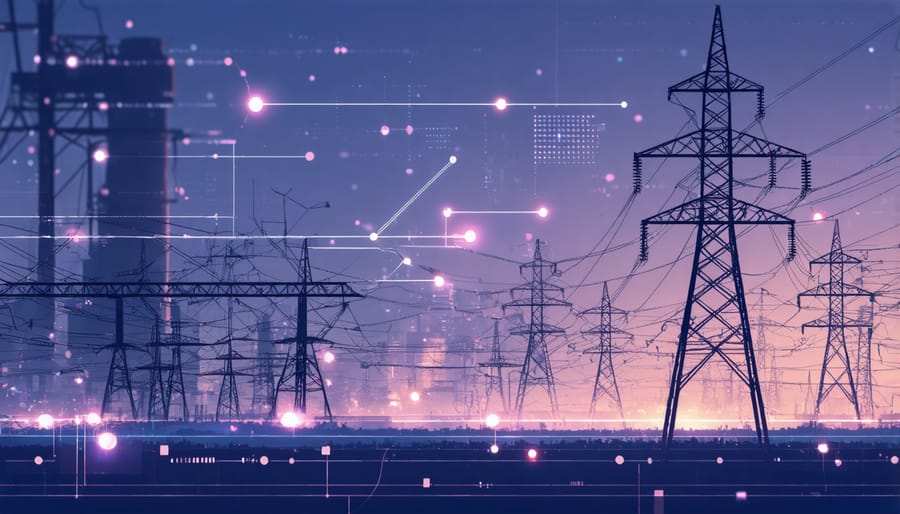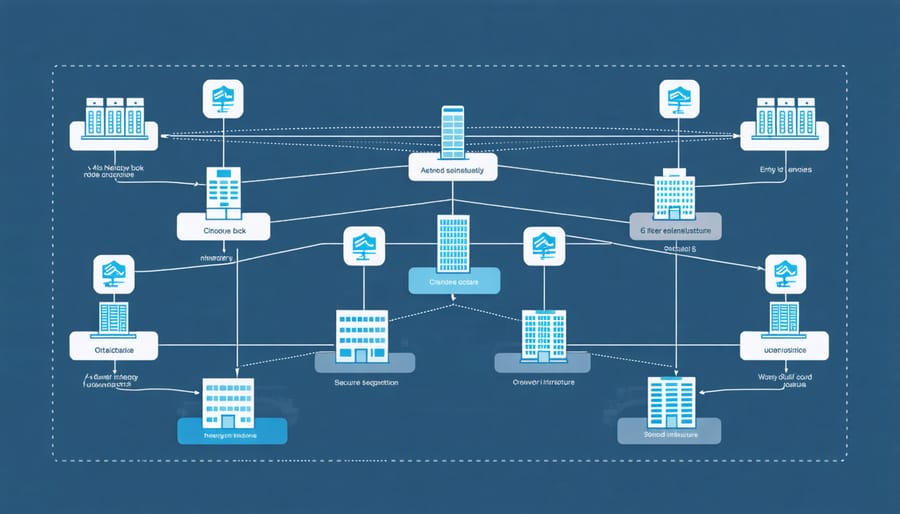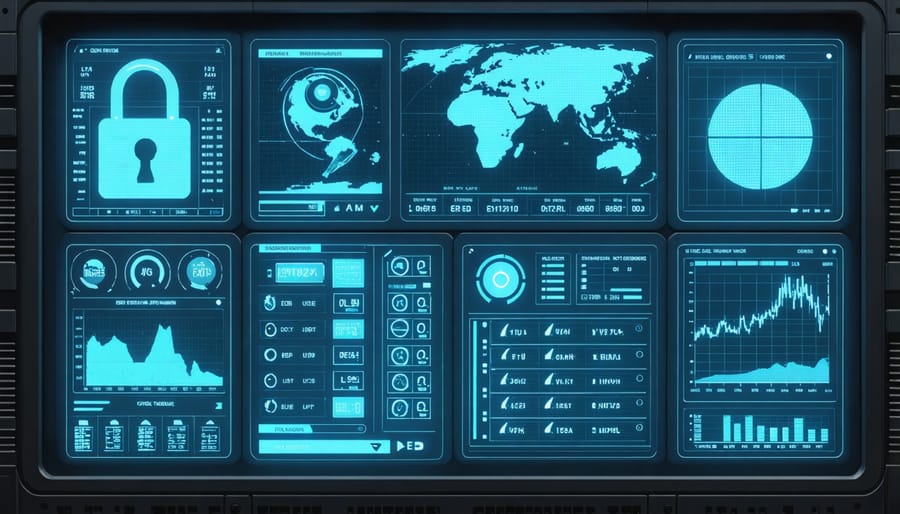The convergence of operational technology (OT) and information technology (IT) in modern energy infrastructure has created unprecedented cybersecurity vulnerabilities that threaten critical power generation, transmission, and distribution systems. Recent attacks on power grids, including the landmark 2015 Ukraine power grid incident and the 2021 Colonial Pipeline ransomware attack, demonstrate the devastating potential of cyber threats to disrupt essential energy services and compromise national security. Energy sector organizations now face a complex threat landscape where state-sponsored actors, cybercriminals, and hacktivists specifically target industrial control systems (ICS), SCADA networks, and smart grid technologies.
Protecting these critical systems requires a comprehensive cybersecurity strategy that addresses both technical vulnerabilities and operational risks unique to the energy sector. From securing legacy systems that were never designed with cybersecurity in mind to defending against sophisticated advanced persistent threats (APTs), energy companies must implement robust security controls while maintaining 24/7 operational reliability. This challenge is further complicated by increasing regulatory requirements, including NERC CIP compliance standards and the EU NIS Directive, which mandate specific cybersecurity measures for energy operators.
As the energy sector continues its digital transformation through initiatives like grid modernization and renewable integration, cybersecurity must be embedded into every aspect of operations. Organizations need to adopt a risk-based approach that combines traditional IT security practices with specialized OT security controls, supported by comprehensive incident response plans and regular security assessments. The stakes couldn’t be higher – a successful cyberattack on energy infrastructure could result in widespread power outages, equipment damage, and potential loss of life.

The Evolving Threat Landscape in Energy Management
Industrial Control Systems (ICS) Vulnerabilities
Industrial Control Systems in the energy sector face unique vulnerabilities that can have severe consequences if exploited. Legacy systems, originally designed without cybersecurity considerations, remain particularly susceptible to modern cyber threats. These systems often run outdated software and protocols that lack encryption and proper authentication mechanisms.
Common vulnerabilities include unpatched software, weak access controls, and insufficient network segmentation between operational technology (OT) and information technology (IT) networks. Many ICS components utilize default passwords and communicate through clear-text protocols, making them attractive targets for cybercriminals.
SCADA systems are especially vulnerable to man-in-the-middle attacks and protocol manipulation. Attackers can potentially intercept and modify control commands, leading to equipment damage or operational disruptions. The increasing connectivity of these systems to the internet, while beneficial for remote monitoring, creates additional attack vectors.
Notable vulnerabilities exist in programmable logic controllers (PLCs), remote terminal units (RTUs), and human-machine interfaces (HMIs). These components often lack robust authentication mechanisms and are susceptible to firmware manipulation. Buffer overflow vulnerabilities in legacy protocols like Modbus and DNP3 can be exploited to gain unauthorized system access.
Recent assessments have identified critical vulnerabilities in wireless communications systems used for remote monitoring and control. These vulnerabilities could allow attackers to intercept sensitive operational data or inject malicious commands into the control system.
Smart Grid Security Challenges
The evolution of smart grid infrastructure has introduced unprecedented cybersecurity challenges to the energy sector. As power systems become increasingly digitized, the attack surface expands exponentially, creating vulnerabilities that cybercriminals can exploit. smart grid management systems face sophisticated threats including advanced persistent threats (APTs), ransomware attacks, and data breaches.
Key security challenges include protecting communication networks between grid components, securing automated control systems, and safeguarding critical infrastructure from both external and insider threats. The integration of Internet of Things (IoT) devices and legacy systems creates additional vulnerabilities, as older equipment often lacks modern security features.
Real-time monitoring and control systems are particularly vulnerable to disruption, potentially leading to widespread power outages or grid instability. Recent industry assessments indicate that supervisory control and data acquisition (SCADA) systems remain primary targets for cyber attacks, with potential cascading effects across interconnected power networks.
Authentication and access control present ongoing challenges, especially in remote substations and distributed energy resources. The need to balance system accessibility for legitimate operations with robust security measures requires sophisticated identity management solutions and continuous security monitoring protocols. As grid technologies advance, cybersecurity strategies must evolve to address emerging threats while maintaining operational efficiency.
Critical Infrastructure Protection Strategies
Network Segmentation and Access Control
Network segmentation stands as a critical defense mechanism in protecting energy infrastructure from cyber threats. By dividing networks into distinct zones based on operational requirements and security levels, organizations can effectively contain potential breaches and minimize their impact on critical systems.
The implementation of industrial demilitarized zones (DMZs) creates secure boundaries between corporate IT networks and operational technology (OT) environments. This separation is essential for protecting critical infrastructure components such as SCADA systems, distributed control systems (DCS), and power management units from external threats while maintaining necessary operational connectivity.
Access control measures complement network segmentation through multi-factor authentication (MFA) protocols and role-based access control (RBAC) systems. These mechanisms ensure that only authorized personnel can access specific network segments, with privileges strictly aligned to job functions and security clearance levels.
Physical security integration plays a crucial role in network architecture design. Security measures such as electronic access controls for server rooms, surveillance systems, and biometric authentication devices create multiple layers of protection for critical network infrastructure components.
Modern energy facilities are implementing Zero Trust architectures, which operate on the principle of “never trust, always verify.” This approach requires continuous validation of every user and device attempting to access network resources, regardless of their location within or outside the network perimeter.
Network monitoring and analytics tools provide real-time visibility into traffic patterns and potential security anomalies. Advanced security information and event management (SIEM) systems help identify and respond to threats before they can compromise critical systems.
Regular security assessments and penetration testing of network segments ensure the effectiveness of implemented controls. These evaluations help identify vulnerabilities in network architecture and provide insights for continuous improvement of security measures.
The convergence of IT and OT networks requires careful consideration of security protocols that can protect both domains while enabling necessary operational integration. This includes implementing secure protocols for data exchange and establishing clear security policies for cross-domain communications.

Real-time Monitoring and Incident Response
In today’s complex energy infrastructure landscape, real-time monitoring systems serve as the first line of defense against cyber threats. These sophisticated platforms continuously analyze network traffic, system behaviors, and operational parameters across energy management infrastructure to detect potential security breaches and anomalies.
Advanced Security Information and Event Management (SIEM) solutions integrate data from multiple sources, including industrial control systems, SCADA networks, and enterprise IT systems. This comprehensive monitoring approach enables security teams to identify and respond to threats before they can impact critical operations.
Incident response protocols in the energy sector follow a structured framework:
1. Detection and Analysis: Automated systems flag suspicious activities and potential breaches
2. Containment: Immediate measures to isolate affected systems and prevent threat propagation
3. Eradication: Removal of threat actors and malicious code from affected systems
4. Recovery: Systematic restoration of systems to normal operations
5. Post-incident Analysis: Documentation and lessons learned to improve future response
Energy organizations are increasingly adopting AI-powered security orchestration and automated response (SOAR) platforms to accelerate incident response times. These systems can automatically execute predefined response protocols, reducing the window of vulnerability during a cyber attack.
Regular tabletop exercises and simulated breach scenarios help response teams maintain readiness and validate incident response plans. These drills often incorporate various stakeholders, including IT security teams, operational technology specialists, and management personnel, ensuring coordinated response capabilities across the organization.
Industry best practices recommend maintaining dedicated security operations centers (SOCs) staffed 24/7 with trained cybersecurity professionals. These teams work in conjunction with automated monitoring tools to provide continuous threat detection and response capabilities, essential for protecting critical energy infrastructure.

Regulatory Compliance and Standards
NERC CIP Requirements
The North American Electric Reliability Corporation (NERC) Critical Infrastructure Protection (CIP) standards form the cornerstone of cybersecurity compliance in the energy sector. These mandatory requirements apply to bulk electric system operators and owners, establishing comprehensive security protocols for critical assets.
NERC CIP encompasses 11 primary standards, ranging from CIP-002 through CIP-014, each addressing specific security aspects. CIP-002 focuses on critical asset identification, while CIP-003 establishes security management controls. CIP-004 through CIP-009 cover personnel security, electronic security perimeters, physical security, systems security, incident reporting, and recovery planning.
Key compliance requirements include maintaining documented cybersecurity policies, implementing access control measures, conducting regular vulnerability assessments, and establishing incident response procedures. Organizations must also perform annual risk assessments, maintain detailed asset inventories, and ensure proper configuration management of critical systems.
Entities must demonstrate continuous monitoring capabilities and maintain audit trails for security events. Personnel training requirements mandate regular cybersecurity awareness programs and role-specific technical training. Physical security measures must integrate with electronic security controls to create comprehensive protection.
Non-compliance with NERC CIP standards can result in significant penalties, potentially reaching up to $1 million per violation per day. Regular audits and assessments ensure ongoing compliance, requiring organizations to maintain extensive documentation and evidence of their security programs.
International Standards and Frameworks
The energy sector’s cybersecurity landscape is governed by several international standards and frameworks that provide comprehensive guidelines for protecting critical infrastructure. The IEC 62443 series stands as the cornerstone for industrial automation and control systems security, offering specific protocols for energy management systems and operational technology.
The NIST Cybersecurity Framework provides a flexible, risk-based approach that many energy organizations globally have adopted. Its five core functions – Identify, Protect, Detect, Respond, and Recover – offer a structured methodology for managing cybersecurity risks in energy operations.
ISO 27001 and ISO 27002 provide broader information security management guidelines that complement sector-specific standards. These frameworks are particularly relevant for energy organizations managing sensitive operational data and IT infrastructure.
The European Network and Information Security Directive (NIS Directive) establishes specific requirements for operators of essential services, including energy providers. Similarly, the North American Electric Reliability Corporation Critical Infrastructure Protection (NERC CIP) standards mandate rigorous cybersecurity measures for bulk electric systems.
Organizations must also consider regional frameworks such as the Australian Energy Sector Cyber Security Framework (AESCSF) and the Saudi Arabian National Cybersecurity Authority (NCA) guidelines. These standards often incorporate elements from international frameworks while addressing unique regional requirements and threats specific to energy infrastructure.
Future-Proofing Energy Management Systems
AI and Machine Learning Applications
In today’s evolving energy sector, AI-driven security solutions are revolutionizing how organizations detect and respond to cyber threats. Machine learning algorithms now analyze vast amounts of operational data in real-time, identifying potential security breaches before they impact critical infrastructure.
These AI systems excel at pattern recognition, monitoring thousands of data points across industrial control systems (ICS) and supervisory control and data acquisition (SCADA) networks. By establishing baseline operational behaviors, AI can quickly flag anomalies that might indicate a cyber attack, such as unusual network traffic patterns or unexpected system commands.
Recent implementations have demonstrated remarkable success in protecting power generation facilities and smart grid infrastructure. For instance, advanced neural networks can predict potential system vulnerabilities by analyzing historical breach attempts and system responses, enabling proactive security measures rather than reactive solutions.
Particularly noteworthy is the integration of machine learning with traditional security information and event management (SIEM) systems. This combination enhances threat detection accuracy while reducing false positives, allowing security teams to focus on genuine threats. The technology also adapts to new attack vectors through continuous learning, ensuring protection against emerging cyber threats in the energy sector.

Zero Trust Architecture Implementation
In today’s evolving threat landscape, the energy sector increasingly adopts Zero Trust Architecture (ZTA) as a fundamental security approach. This model operates on the principle of “never trust, always verify,” requiring continuous authentication and validation of all users and devices attempting to access network resources, regardless of their location or previous access privileges.
For energy systems, ZTA implementation involves segmenting critical infrastructure into distinct security zones, with strict access controls between each segment. Industrial Control Systems (ICS), SCADA networks, and corporate IT infrastructure are isolated, with controlled interconnections monitored through security gateways and next-generation firewalls.
Key components of ZTA in energy systems include:
– Micro-segmentation of operational technology networks
– Multi-factor authentication for all access points
– Continuous monitoring and verification of device identity
– Real-time threat detection and response capabilities
– Encrypted communication channels between all system components
Success in implementing ZTA requires a phased approach, starting with critical assets and gradually expanding across the infrastructure. Organizations must maintain detailed asset inventories, implement robust identity management systems, and establish clear security policies aligned with regulatory requirements.
Recent implementations have shown significant improvements in threat detection and incident response times, with some utilities reporting up to 60% reduction in unauthorized access attempts. However, the transition requires careful planning to avoid disruption to essential operations and services.
As the energy sector continues to embrace digital transformation, the importance of robust cybersecurity measures cannot be overstated. Our comprehensive analysis has highlighted several critical aspects that energy industry stakeholders must address to maintain operational resilience and protect critical infrastructure.
The implementation of multi-layered security protocols, regular system audits, and employee training programs form the foundation of an effective cybersecurity strategy. Organizations must prioritize the integration of advanced threat detection systems while maintaining compliance with evolving regulatory frameworks.
Based on industry best practices and expert insights, we recommend the following action items:
1. Conduct quarterly vulnerability assessments of all operational technology systems
2. Implement zero-trust architecture across energy management networks
3. Establish clear incident response protocols and regularly test them through simulations
4. Invest in AI-powered monitoring tools for real-time threat detection
5. Develop partnerships with cybersecurity firms specializing in industrial control systems
The energy sector’s cybersecurity landscape will continue to evolve, requiring constant vigilance and adaptation. Organizations should allocate sufficient resources for regular security updates and maintain open communication channels with industry peers and regulatory bodies.
By implementing these recommendations and staying informed about emerging threats, energy companies can better protect their assets and ensure the reliable delivery of essential services to their customers. The future of energy security depends on our collective commitment to maintaining robust cybersecurity practices today.

